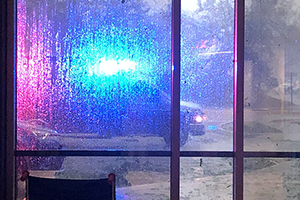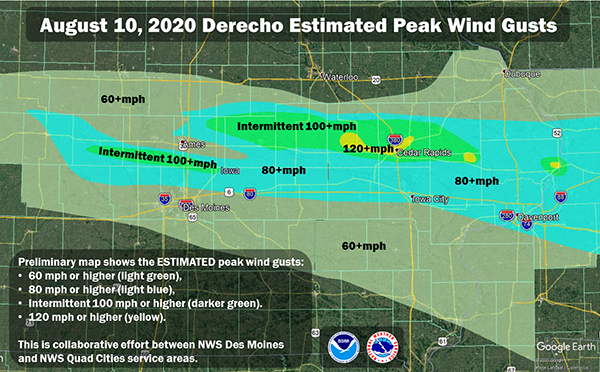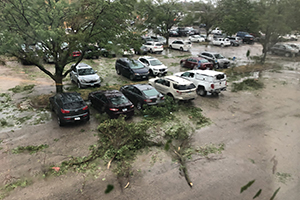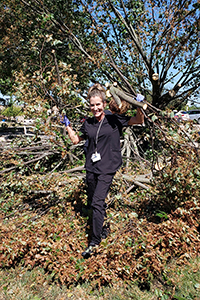By JULIE MINDA
Sept. 8, 2020

An ambulance departs from Mercy Medical Center in Cedar Rapids, Iowa, as the storm begins to subside.
The highly destructive windstorm that crossed the Midwest Aug. 10 wreaked havoc in communities throughout Nebraska, Iowa, Illinois, Indiana, Wisconsin and Michigan. In just four hours, the derecho, which is a large fast-moving, organized line of thunderstorms packing powerful straight-line winds, crossed 800 miles. It destroyed homes, businesses and farms; downed trees and crops; and left about 800,000 people without electricity, according to USA Today coverage.
The highest measured winds were in Iowa, where the National Weather Service reported peak gusts ranging from 100 — 120 plus mph. Representatives of several Catholic hospitals in Iowa say despite very challenging conditions in the aftermath of the gale, their organizations maintained high-quality patient care and provided aid to the community.
"In the midst of a disaster, our MercyOne colleagues rose to the challenge and shined brightly," says Laurie Conner, president of MercyOne Newton Medical Center in Newton, Iowa. "While many of our colleagues faced personal challenges in their own homes, they did not hesitate to help their community rebound."

Estimates had wind gusts reaching upwards of 120 mph near Cedar Rapids, Iowa, during the derecho.
National Weather Service and the National Oceanic and Atmospheric Administration.
MercyOne Newton and other ministry facilities in storm-devastated communities now are focused on continuing to support affected employees — and the facilities anticipate responding to socioeconomic need in the community well into the future.
Destruction and debris
Ministry facilities in communities ravaged by the derecho include the 445-bed Mercy Medical Center of Cedar Rapids; the 48-bed MercyOne Newton; the 163-bed MercyOne Clinton Medical Center of Clinton; and the 606-bed MercyOne Des Moines Medical Center of Des Moines. MercyOne is a network of eight medical centers and other facilities. MercyOne is a joint operating agreement between Trinity Health and CommonSpirit Health.
The stand-alone Mercy Cedar Rapids and its outpatient sites sustained widespread but no catastrophic damage. Most of the outpatient facilities lost power and clinics had superficial building damage, water leaks, downed trees and damaged trees, says Dr. Timothy Quinn, the hospital's executive vice president and chief of clinical operations and president of Mercy Care Management. He says the hospital ran on generator power for several days, necessitating rescheduling of elective procedures; and Mercy Cedar Rapids' outpatient sites without power were temporarily closed. All services were restored within a week of the derecho."
A record-setting number of people sought care in Mercy Cedar Rapids' emergency department in the storm's wake — about 250 daily, as compared to the usual 150 to 170, says Karen Vander Sanden, Mercy Cedar Rapids public relations specialist. About 70 percent of them had storm-related injuries. This included lacerations, eye injuries and orthopedic issues related to storm cleanup; and acute respiratory and cardiovascular conditions related to being without air conditioning.
Quinn says people also flocked to the hospital to charge medical equipment and to keep insulin cold as well as to charge cell phones.
Quinn, who helped to staff an around-the-clock incident command center at Mercy Cedar Rapids, says while hospital staff could communicate internally with technology powered by generator, external landlines, cell phones and internet all were down. The command center struggled to connect with local authorities, sometimes resorting to dispatching staff by car to city offices.
At Mercy Cedar Rapids, about 140 employees have sought relief from Mercy Foundation for derecho-related damages. That foundation has disbursed more than $66,500 and anticipates providing further assistance. According to Vander Sanden, employees most commonly have been seeking aid to cover insurance deductibles and other repair costs, to replace food lost in power outages, for tree removal and rent or mortgage assistance.
Sweltering conditions
MercyOne Newton sustained only superficial damage to its building. The hospital was on generator power for 33 hours; it had no air conditioning during that time period and its medical office building had no power. The disaster came on top of a pandemic. Connor says as they labored in the heat and humidity, staff wore personal protective gear as a contagion precaution.

Trees and limbs strewn about the campus of Mercy Medical Center in Cedar Rapids.
The hospital remained open for inpatient care but suspended elective procedures and closed the medical offices until power was restored. With about 50 patients a day, the medical center's emergency department had nearly twice its pre-storm patient volume in the days after the storm. Nursing staff from other departments pitched in.
Similarly, MercyOne Clinton relied on generator power as it responded to an increase in ER traffic. Outpatient sites were closed temporarily due to power outages.
Clean clothes and a meal
Connor says many employees at MercyOne Newton took the initiative to help their colleagues and their neighbors. Laundry services team members helped staff to wash their personal laundry in the hospital's machines. And nutrition services prepared or secured about 300 box meals over several days for employees who had no electricity at home.
Some staff took care of colleagues' children when day cares closed due to power outages. Some associates gave rides to colleagues whose cars were destroyed or blocked in by storm debris. Dozens of employees served on volunteer crews that Newton organizations pulled together to clean up debris.
Connor says impassible roads were a significant problem in the aftermath of the storm. One patient had to be transported to the hospital in a pickup truck because ambulances could not navigate the debris-littered roads.
Shoulder to the wheel
Quinn in Cedar Rapids says he has been moved by employees' selflessness in the wake of the derecho. Although staff were fretting about loved ones they couldn't reach, and worrying about damage to their homes or property, they came into work and took care of patients, community members and each other. Many employees volunteered to clear debris in neighborhoods after they'd ended their shifts at the hospital.

Michele Tharp, a member of the radiology team at MercyOne Newton Medical Center in Newton, Iowa, helps to clear tree debris on the campus.
Mercy Cedar Rapids set up a system to match staff members needing cleanup help with colleagues volunteering to assist them.
The hospital's nutrition staff baked hot meals for employees to take home while they were without power, and produced nearly 3,000 meals that Mercy gave to frontline responders including utility workers and cleanup crews.
Karl Keeler, president of MercyOne Central Iowa, says when Polk County Community, Family and Youth daily meal program for senior adults was disrupted due to power outages, the MercyOne Des Moines nutrition team prepared more than 1,100 meals daily for three days. "MercyOne was proud to pay it forward by supporting this much-needed community resource during a crisis," says Keeler, noting that the Des Moines community has been a great support to MercyOne throughout the pandemic.
Agribusiness is central to the economy of Iowa and Cedar Rapids. Widespread damage to crops and farm buildings compounds the economic hardships brought on by the pandemic and trade wars. Vander Sanden says she expects Mercy Cedar Rapids to play an ongoing role in addressing socioeconomic need in Cedar Rapids.
Oxygen deliveries
Annette Zemek, MercyOne Clinton home medical equipment director, says her staff responded to calls from home care patients needing oxygen tanks amid the power outages. Even though members of the team had their own personal concerns to worry about – such as damaged homes – they worked for upwards of 14 hours per day for days in a row to ensure patients' medical equipment needs were met.
Two-person delivery teams dodged broken limbs and downed powerlines on darkened streets to bring emergency supplies to their clients. They used flashlights and cell phone lights to find house numbers on mailboxes. The team made 250 home oxygen deliveries within the first four days of the storm.
"They worked without complaining into the wee hours of the night, returning and asking, 'What's next?'" says Zemek.
Laura Flint, whose husband Thomas relied on that oxygen, says of the team, "I call them my angels, because they delivered tanks of oxygen at one in the morning. We couldn't have gotten through this week without those gals. They were true angels through all of this."
Copyright © 2020 by the Catholic Health Association
of the United States
For reprint permission, contact Betty Crosby or call (314) 253-3490.